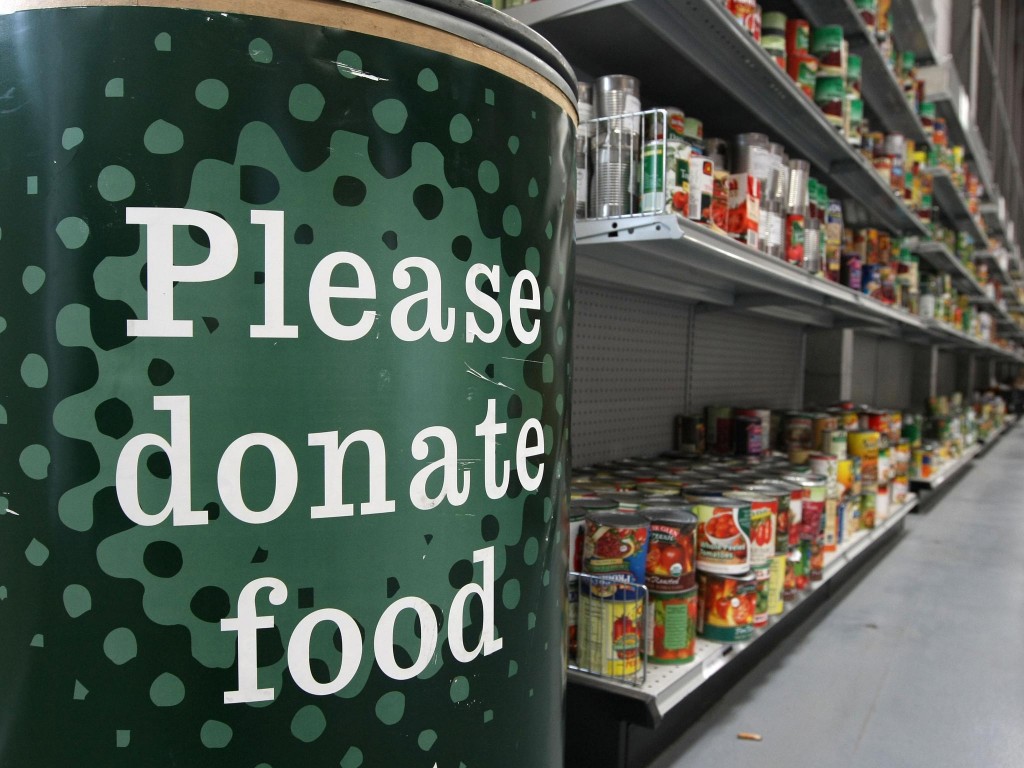 By Star Fox
By Star Fox
What does it tell you about the U.S. economy when lines at food banks across the country have steadily increased since 2008. Does it sound like an economy that is recovering?
Of course not.
According to The Associated Press there are some people out there who actually believe that the U.S. economy has improved since the collapse of 2008, despite the increase in demand for free food from food banks being a huge red flag signaling the opposite.
The Associated Press reports:
Food banks across the country are seeing a rising demand for free groceries despite the growing economy, leading some charities to reduce the amount of food they offer each family.
U.S. food banks are expected to give away about 4 billion pounds of food this year, more than double the amount provided a decade ago, according to Feeding America, the nation’s primary food bank network. The group gave away 3.8 billion in 2013.
While reliance on food banks exploded when the economy tanked in 2008, groups said demand continues to rise year after year, leaving them scrambling to find more food.
“We get lines of people every day, starting at 6:30 in the morning,” said Sheila Moore, who oversees food distribution at The Storehouse, the largest pantry in Albuquerque, New Mexico, and one where food distribution has climbed 15 percent in the past year.
******
James Ziliak, who founded the Center for Poverty Research at the University of Kentucky, said the increased demand is surprising since the economy is growing and unemployment has dropped from 10 percent during the recession to 5.3 percent last month.
However, many people who have found jobs are working only part-time or for low wages, and others have stopped looking for work.
The unemployment number cited by James Ziliak of 5.3% is a result of deceptive calculating. Government unemployment totals tell a story that is completely disconnected from the actual economy.
In the month of June the unemployment rate, by the federal government’s calculations, fell to 5.3% solely because 640,000 Americans left the labor market.
 In July the unemployment rate remained at 5.3%; but, again, a record number of people left the labor force.
In July the unemployment rate remained at 5.3%; but, again, a record number of people left the labor force.
According to Bureau of Labor Statistics report for July, 93,770,000 people (16 and older) were neither employed nor had made specific efforts to find work in the prior four weeks. That’s a 144,000 increase over June’s record when 93,626,000 were absent from the workforce.
Also, AP is correct when they say that Americans are working for less pay in part-time positions.
In fact, some independent calculations actually bring the unemployment rate to 23%.
From Paul Craig Roberts:
In 1994 the Clinton regime stopped counting long-term discouraged workers as unemployed. Clinton wanted his economy to look better than Reagan’s, so he ceased counting the long-term discouraged workers that were part of Reagan’s unemployment rate. John Williams (shadowstats.com) continues to measure the long-term discouraged with the official methodology of that time, and when these unemployed are included, the US rate of unemployment as of July 2015 is 23%, several times higher than during the recession with which Fed chairman Paul Volcker greeted the Reagan presidency.
An unemployment rate of 23% gives economic recovery a new meaning. It has been eighty-five years since the Great Depression, and the US economy is in economic recovery with an unemployment rate close to that of the Great Depression.
The labor force participation rate has declined over the “recovery” that allegedly began in June 2009 and continues today. This is highly unusual. Normally, as an economy recovers jobs rebound, and people flock into the labor force. Based on what he was told by his economic advisors, President Obama attributed the decline in the participation rate to baby boomers taking retirement. In actual fact, over the so-called recovery, job growth has been primarily among those 55 years of age and older. For example, all of the July payroll jobs gains were accounted for by those 55 and older. Those Americans of prime working age (25 to 54 years old) lost 131,000 jobs in July.
It should come to no one’s surprise that with so many Americans out of work and with so much dependency on government that the demand at food banks is rising.
Star Fox is a U.S. based journalist who contributes to Eyesopenreport.com. His works have been published by recognizable alternative new sites like GlobalResearch.ca, ActivistPost.com and Intellihub.com. Follow @StarFoxReport

The last time I needed the food bank I was 6’1, 215 pounds and the skinniest adult in line. Somewhere between half and two-thirds of the people in line showed their cable bill as proof of residence. There was only one other person there besides me without a car. Admittedly probably some vehicles were borrowed. The experience made me wonder how many people there really needed help (my guess is not many), and how many were there to get a freebie that let them spend their money on more important things, like cable, cigarettes, and booze.
The way I see it people need to take life into their own hands now days, you can do that by learning how to trade the markets. I’ve been learning to the website Code Trading System they have excellent videos and I just got their deal they are running and I’m very happy with their course material. The instructor is a very knowledgeable trader. I’ve been doing really well so far and my goal is within one month to quit my job and I believe I can do it.